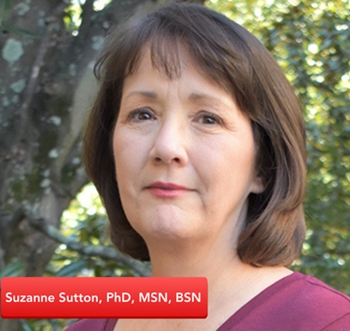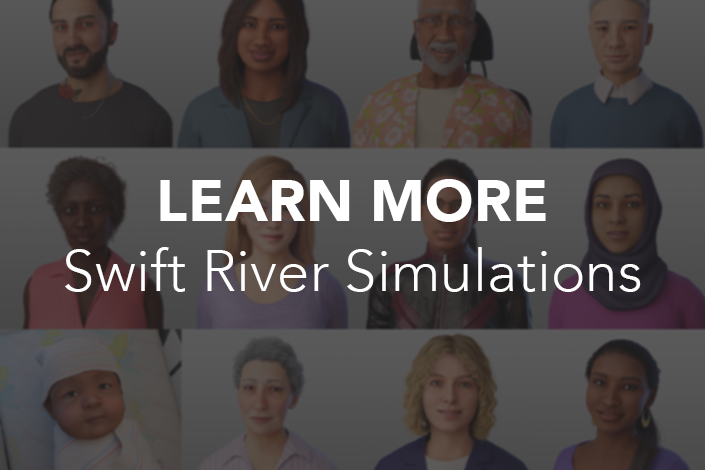Using simulation to build deeper understanding and better decision-making skills in nursing students
One way that nursing programs are maximizing the impact of simulation is by using it to provide enhanced learning at critical junctures in the curriculum.
At the University of South Carolina (USC) College of Nursing in Columbia, S.C., Suzanne M. Sutton, PhD, MSN, BSN, CNE, has incorporated Swift River Simulations as a bridging resource between two courses. And it’s paying off in notable ways.
Bridging a gap and building knowledge
Dr. Sutton is an Assistant Professor and the Coordinator of the Program for Academic Support at USC. During the spring 2024 term (cohort of 160), she incorporated Swift River Simulations to help students make a stronger transition from her Foundations of Nursing class to her Medical-Surgical Nursing I class.
 Swift River Simulations provides 650+ screen-based simulation scenarios that unfold as the student interacts with each simulation, prompting them to make clinical decisions and practice analytical thinking, prioritization, and delegation.
Swift River Simulations provides 650+ screen-based simulation scenarios that unfold as the student interacts with each simulation, prompting them to make clinical decisions and practice analytical thinking, prioritization, and delegation.
Dr. Sutton recognized Swift River Simulations as a resource to keep students learning as they wait for their clinical site to process facility requirements.
“Swift River Simulations can mirror very well what we have been teaching in class and serve as a bridge from Fundamentals to Med-Surg,” she said. “This is what I was looking for, because it takes 2 to 3 weeks to get the students into the hospital to actually start clinical.”
Setting the stage for enhanced learning
To maximize the effectiveness of using Swift River Simulations at this stage of the program, students completed prework to prepare for the virtual simulation day. This prework included content such as End-of-Life Care and Wellness-Illness, which are assignments in Engage™ Adult Medical-Surgical.
Additionally, students created active learning templates for medications and nursing procedures to review material from Fundamentals. Following this preparation, the students worked through assigned scenarios.
“I told them that virtual simulation is not something that just earns them a check mark for completion,” she said. “I explained that it would help them in the hospital.”
Dr. Sutton assigned Swift River Simulations modules in which students would review and practice passing medication and perform focused assessments. These scenarios also prompted them to apply knowledge about social determinants of health (SDOH) and end-of-life (EOL) care.
During their Fundamentals course, students had exposure to these topics in Engage™️ Fundamentals. This ATI solution provides interactive digital learning experiences using multimedia delivery of unfolding case studies, quizzes, clinical judgment activities, and podcasts.
“We used patient scenarios in Engage™ Community & Public Health to help students deepen their understanding of SDOH, which they had been introduced to in Engage Adult Medical-Surgical,” she said. “Then as they used Swift River Simulations, students were able to provide care and ‘walk through’ the death and dying process with a patient who had been admitted to home hospice.”
Dr. Sutton extended the simulation learning by requiring students to complete a reflection activity within 6 hours of finishing the scenarios. She also established a discussion board for confidential sharing about the feelings the students experienced.
Understanding and applying information
Students told Dr. Sutton that the focused content in the Swift River Simulations help them “see” the concepts they had been taught in the didactic portions of the Medical-Surgical course. “They said they had a deeper understanding and better ability to apply the information,” she explained.
“The comments we got from students about Swift River were amazing. One of the students said it felt very similar to a patient interaction,” Dr. Sutton said. “They said they felt like they understood information about social determinants of health better, and that it helped them recall information from health assessment. And the medication administration scenario really helped them think about delegating.”
Improving outcomes and learning
Prior to incorporating Swift River Simulations, learning objectives were harder to meet and students were not as engaged, Dr. Sutton said. After incorporating the resource, “student feedback is promising and the outcomes on the unit exam were good.”
The students in the cohort expressed their interest in continuing to use Swift River Simulations as they progress in the program.
“They are very ready to continue using it because we presented it in a way that they saw was beneficial,” Dr. Sutton said. “We helped them see it as a learning tool as opposed to an assignment.”
When asked what she considers the most significant benefits of Swift River Simulations, Dr. Sutton said: “It is easy to integrate, it provides immediate feedback, it’s flexible, and it’s shorter than some other simulation programs.”
Dr. Sutton said she plans to continue to incorporate Swift River Simulations in her teaching, and that she views it as a component of her strategy to give students “anchors” for their knowledge and eventual clinical practice.
“As students learn new information, they develop anchors for different ways of thinking about things,” she said. “That’s what this interaction in Swift River does. It takes them beyond the reading and rereading, writing and rewriting to actually using their knowledge.”

